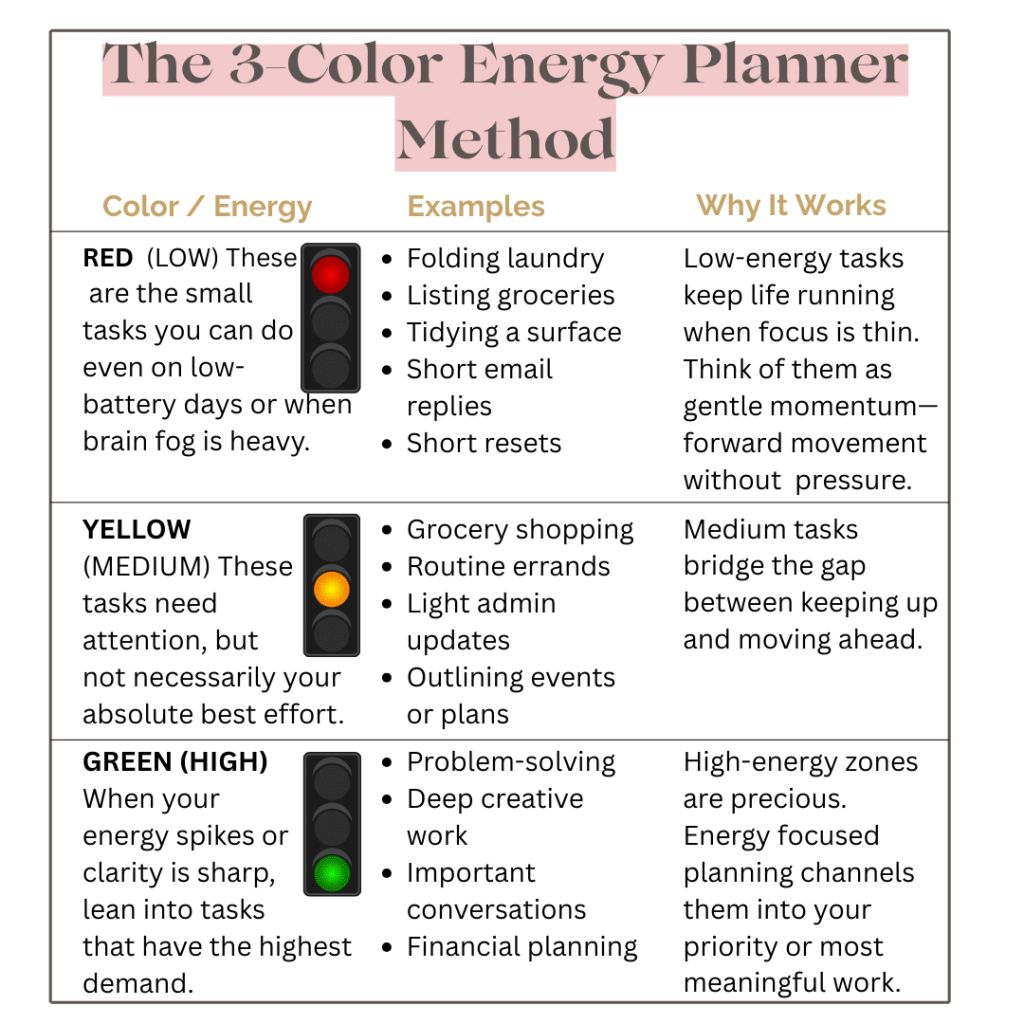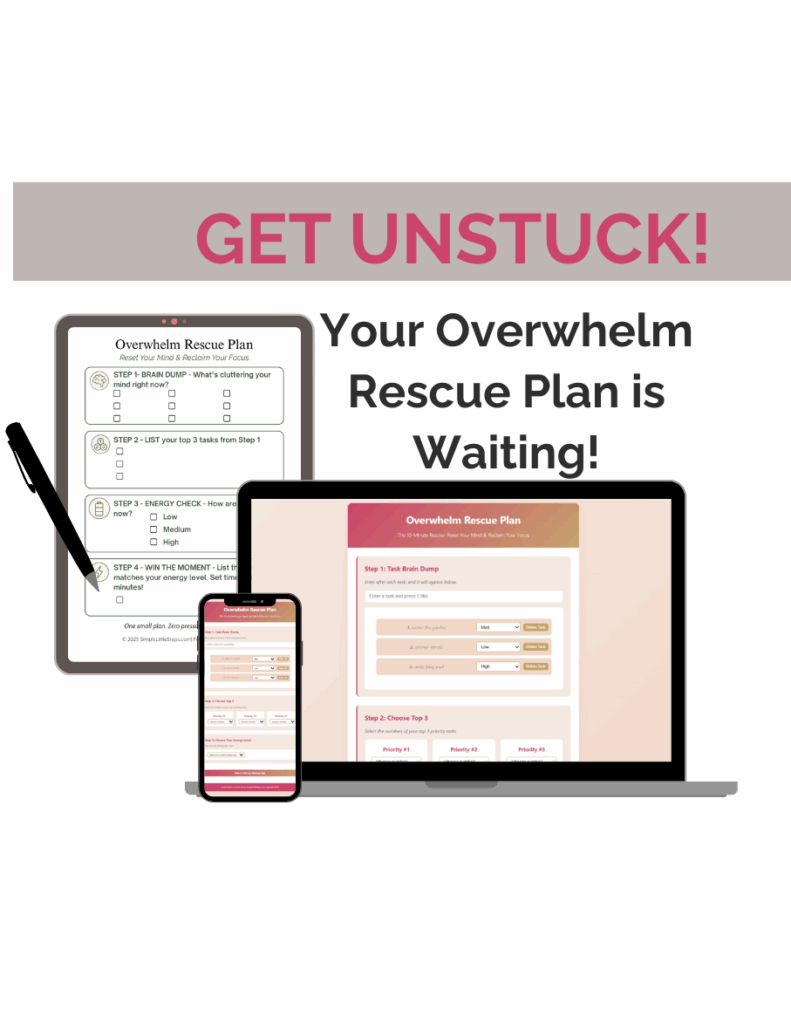Plan Your Day by Energy (My Low/Medium/High Task System)
Some days, even answering an email feels like a lot. If traditional to-do lists have you spinning, an energy planner flips the script: instead of forcing yourself into tasks, you match tasks to the energy you actually have, in the moment. No drama, no guilt—just gentle structure that respects your capacity. This is the system I reach for when brain space is tight and I still want to make steady progress.
Quick note: when I say “energy planner,” I mean a way to plan by personal energy. You can use this Low/Medium/High method in any notebook—or inside my Low-Energy Focus Planner.
Quick Read – Plan by Energy
- Sort your to-dos by Low / Medium / High energy instead of urgency.
- Use your energy planner method to pair the right task with the energy you have at the moment (great for days with brain fog).
- Low = mindless maintenance; Medium = focused but low-stakes; High = deep, creative, or decision-heavy work.
- Track daily energy with a simple 3-color method to see patterns and plan accordingly.
How the Energy Planner Method Works (and Why It Beats a Traditional To-Do List)
A traditional list typically encourages you to time block in your calendar to complete each task. This energy planner method of assigning tasks doesn’t. It organizes your day by how much mental and emotional fuel each tasks require. If you’re navigating brain fog or fluctuating capacity, this is a relief—you can still move forward without overloading your system.
It Respects Your Natural Energy Fluctuation
Your focus fluctuates throughout the day and the week. The planning by energy honors that reality instead of fighting it. You’ll stop wasting good energy on tasks that don’t need it—and stop beating yourself up when you can’t force a “high” output day.
It Reduces Decision Fatigue
When you’re tired, choosing what to do next can be the hardest part. Using a method that plans by energy removes that decision for you. You simply scan your buckets and select a task that aligns with how you feel at the moment. This is especially helpful when brain fog makes prioritizing feel impossible.
It Builds Sustainable Progress
Consistency beats intensity. Even on low days, you’ll have a list of doable tasks that keep life moving. On bright days, you’ll know exactly where to place that extra clarity—without hunting through a chaotic list.
It Also Works With Brain Fog, Not Against It
When the fog rolls in, priorities blur and the first step goes missing. Pre-sorting by energy gives you a starting line you can actually find—even when thinking feels slow. Instead of deciding what matters, you simply match the moment you’re in to the next right task.
It Separates Your Identity from Output
On a foggy day, you’ll do a Low-level task. On a blue-sky day, you’ll go with something that requires more High-level focus. Either way, you’re following the plan and keeping yourself moving forward. That shift lowers shame and stops the doom-spiral of self-worth.
Why an Energy Planner Method Works
The energy planner method is built around Low, Medium, and High energy zones. Instead of forcing every task into a rigid time block, you match the right task to your current energy level. This chart shows how each energy bucket supports your focus and helps you stay productive without burning out.

The 3-Color Low/Medium/High System (Step-by-Step)
1. Start with the 3-Color Method
In whatever planner you have available right now, or just on a piece of paper, begin to color-code your daily energy so planning takes seconds. These are the three highlighter colors I use (and ONLY three!):
- Sage Green (High): Clear focus, creative flow, decision-ready
- Pale Mustard Yellow (Medium): Usable focus, better with structure
- Rusty Rose (Low): Minimal capacity, keep it gentle
Remember!
That awareness turns into practical planning, such as preparing easy dinners, doing your prep midday, or taking a late-afternoon refresh break.
For five months, a three-week treatment cycle made my energy predictable—low, then medium, then high—the easiest plan I’ve had. This month, the schedule flipped to medium mornings and low afternoons. It felt like an emotional hit, but the three-color energy planner made the pivot simple. Because I’ve seen it work, I swapped disappointment for confidence and kept moving.
2. Assign Tasks to Buckets (Not Time Slots)
Make this step as easy as you can for yourself. On sticky notes, a notebook page, or even your phone, mark three columns to list your to-dos for the week as Low / Medium / High. Stick with a timer to limit this Clarity Capture, and keep it to no more than 20 items.
Keep this 3-column energy task list close at hand for easy reference in the coming week. The point is fast alignment. At the beginning of every day and between tasks, check in with your current energy color, then choose a matching task.
- Feeling Low? Grab a Low task or two and call it enough.
- Feeling Medium? Queue up a Medium batch of tasks, and start with the most important one.
- Feeling High? Protect that window for one meaningful High-level task.
Tips for Using the 3-Color System
Protect Your Highs
When you’re in a Green (High) zone, silence notifications, tell people you’re unavailable, and choose one High-energy task from your list. Multitasking drains even great energy. One High task finished is worth more than three started.
Pro tip: Pair your High window with a ritual—such as tea, a playlist, or a brief walk—to cue your brain that it’s time to focus. This is especially helpful on days when brain fog starts to lift and you want to ease into more in-depth work.
Brain Fog Caution: If your mind starts to drift or your energy starts to drain during one of these High zone task sessions, refer back to my handy list of 10 Favorite Brain Fog Tips and do one of the quick 3-5 minute breaks suggested.
Energy Planner: Stack Medium Tasks for Momentum
Batch MEDIUM tasks by theme (work, home, family). You’ll move faster because you’re not context-switching. If your focus slips, switch to a Low task and return later.
Energy Planner: Keep a “Low-Energy Rescue” List
Create a special Low list for days that feel especially heavy—tiny, five-minute wins when your tank is near empty:
- Clear five emails
- De-clutter or wipe down one counter
- Put one load of laundry in
- File three digital documents
My Real-Life Examples of the Energy Planner in Action
Here’s how my plan unfolded just last week:
My Energy Planner: A Medium-Low Monday-Tuesday
- Morning (MEDIUM): Worked on an LLM Module from a training course; Outlined and edited a blog post (YELLOW).
- Midday (LOW): Rest and Refresh breaks; made meal plan for next week (PINK).
- Afternoon (LOW): Created grocery list and ordered grocery delivery (PINK).
Note that before my low-energy and brain fog hit me over a year ago, I would never have ordered a grocery delivery. But I accepted my new reality, and now I have my weekly groceries delivered without any guilt!
My Energy Planner: A Surprise Clear-Head Wednesday
- Morning (HIGH): Since this was unexpected, I quickly swapped in two High-energy tasks and completed two blog posts from start to finish! (GREEN)
- Midday (LOW): Rest and Refresh break (PINK).
- Late Afternoon (LOW): Streamed a fun rom-com – I really needed a break! (PINK).
Since I live at home with a full-time remote worker husband and two adult children, I made sure to let everyone know that I was in full-on ninja mode that morning and not to disturb me!
My Energy Planner: A Medium-Low Thursday-Saturday
- Morning (MEDIUM): Outlined and edited another blog post, completed my LLM course, and on Saturday, I used my favorite AI to prioritize my work tasks for next week, ranking them in Low, Medium, and High buckets (a brilliant move!) (YELLOW).
- Midday (LOW): Rest and Refresh breaks (PINK).
- Afternoon (LOW): Spent several afternoons doing family and home-related tasks (PINK).
Sometimes, when I’ve had a morning of medium-energy tasks, if I have the time and energy, I’ll start a high-energy task and then make a note of what I need to complete on that task at another time.
Following this plan has really lifted my spirits, helped me feel as though I was accomplishing something every day (rather than blowing off the whole day), and it’s built my momentum as I head into the following week.
FAQ: The Energy Planner Method
Common questions about using the energy planner method in real life.
What if my day changes suddenly?
That’s expected. The energy planner method uses flexible buckets, not rigid time blocks. If energy dips, switch to a Low or Medium task; if it rises, grab a High task—lane-switching is built in.
How many tasks should I keep in each bucket?
Keep lists scannable: about 5–8 tasks per bucket. Archive or move finished items weekly so your lists stay breathable and match your energy flow.
What if everything feels “High”?
It’s usually a bundle hiding multiple steps. Define the outcome, break it into bite-size pieces, then tag each step Low, Medium, or High so you can keep momentum as energy shifts.
Can I use this with any planner or just yours?
Any notebook or app works. My Low-Energy Focus Planner simply gives guidelines for running the energy planner method daily.
Work the list by energy, not ego. If brain fog rolls in, grab a Low step. When clarity returns, slide into a Medium or High task without starting from scratch. The energy planner helps you right-size them so progress is always available.
Simple Action Steps
- Color your day: Mark your next three days with Green/Yellow/Pink check-ins in real time..
- Bucket your list: Sort your current tasks into Low/Medium/High categories.
- Create a rescue list: Add five small, low-priority tasks you can do during moments of heavy brain fog.
Final Thoughts
You don’t have to earn rest or force focus. Let your energy ebb and flow. An energy planner meets you where you are—taking the pressure off “performing” and putting it on steady, humane progress. That’s how real work happens on real-life days.
When cancer hit, everything shifted. I developed simple planning tools to navigate low-energy periods and overcome brain fog. Tired of the shame spiral, I changed my mindset, honored my limits, kept going—and realized this framework could help other women navigating fatigue and fog, too.
Now most days end feeling finished, not failed. I notice what I did, not what I didn’t. I break work into small steps and leave room for what matters—more meaning, greater ease, and better balance.
If you have days like mine, I urge you to try out my new “Overwhelm Rescue Plan!” It’s a great introduction to my 3-Step Clarity System, to be released in just a few weeks. PLUS you’ll get a special bonus as a new subscriber!

When your brain feels crowded and you’re tired of pushing, the Overwhelm Rescue Plan guides you through a quick reset that turns fog into forward motion. It’s designed for transformation—from scattered to steady, from foggy to focused—so you can return to clarity and calm living fast.
- A guided, fill-in form with blank spaces to capture your answers to four key prompts
- A compassionate mini-process that lowers cognitive load and sparks momentum
- You’ll receive: a printable/annotatable PDF (perfect for paper or tablet) plus access to an interactive web page that makes the reset feel twice as easy
Because you don’t need more willpower—you need a 10-minute path back to yourself.
